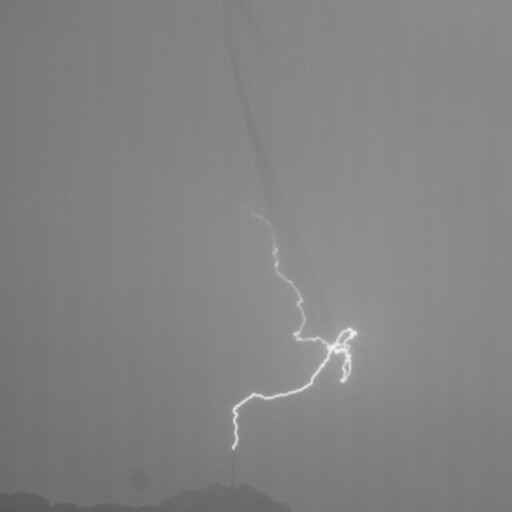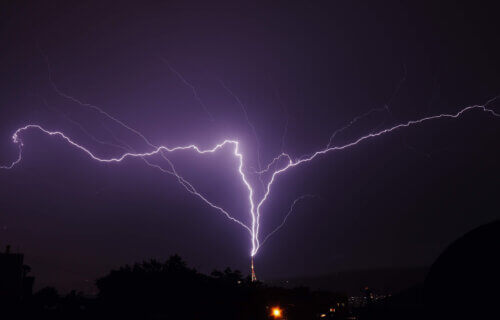LAUSANNE, Switzerland — Few things can so frequently capture the awe of humans across the globe quite like lightning that bursts through the night sky. But beyond its mesmerizing beauty, lightning is a powerful and complex natural phenomenon that scientists are still working to fully understand. Now, a team of researchers from Switzerland and Sweden has made a groundbreaking discovery that sheds new light on the mysteries of lightning: the first-ever observations of X-rays produced by upward positive lightning.
Lightning comes in many different forms, but one of the most intriguing is upward lightning. As the name suggests, upward lightning originates from the top of tall structures like skyscrapers, wind turbines, or communication towers and shoots up towards the clouds. It’s a relatively rare phenomenon, but one that can cause significant damage due to the repeated strikes that often occur.

The research team, led by Toma Oregel-Chaumont of the Swiss Federal Institute of Technology in Lausanne (EPFL), made their discovery at the Säntis Lightning Research Facility in the Appenzell Alps of northeastern Switzerland. This unique facility is situated on the top of Mount Säntis, a 2,502-meter-high mountain that experiences over 100 direct lightning strikes per year to its 124-meter-tall tower. The tower is equipped with an array of sophisticated instruments, including high-speed cameras, X-ray detectors, electric field sensors, and current-measuring devices.
Using these instruments, the team captured and analyzed four upward positive lightning flashes. They detected bursts of X-rays during the initial phase of the upward negative leader, the part of the lightning that propagates upwards from the tower in a stepwise manner. This is the first time that such X-ray emissions have been directly associated with the “stepping” process of an upward negative leader.
“The actual mechanism by which lightning initiates and propagates is still a mystery,” says Oregel-Chaumont, a PhD candidate at EPFL’s Electromagnetic Compatibility Lab, in a media release. “The observation of upward lightning from tall structures like the Säntis tower makes it possible to correlate X-ray measurements with other simultaneously measured quantities, like high-speed video observations and electric currents.”
The X-rays observed in this study are thought to be produced by a process known as “bremsstrahlung,” which occurs when electrons are suddenly decelerated. The intense electric fields generated during the lightning discharge accelerate electrons to high speeds. When these electrons collide with air molecules, they are abruptly slowed down, releasing their excess energy in the form of X-rays.
Interestingly, the researchers found that the frequency and energy of the X-ray pulses decreased over time, with the pulses disappearing altogether within the first millisecond of the leader initiation. This suggests that as the leader tip moves away from the tower and the electric field strength decreases, the conditions become less favorable for X-ray production.
Furthermore, the X-ray emissions seemed to be correlated with the maximum current change (the speed at which the electric current increases) and the change in the electric field associated with each leader step. This supports the idea that it’s the rapid changes in the electric field that drive the acceleration of electrons and the subsequent generation of X-rays, a process known as the “cold runaway electron mechanism.”

The speed and sensitivity of the equipment at the Säntis facility allowed the team to see a difference between negative leader steps that emitted X-rays and those that did not, supporting the cold runaway electron model. “As a physicist, I like to be able to understand the theory behind observations, but this information is also important for understanding lightning from an engineering perspective,” says Oregel-Chaumont. “More and more high-altitude structures, like wind turbines and aircraft, are being built from composite materials. These are less conductive than metals like aluminum, so they heat up more, making them vulnerable to damage from upward lightning.”
This study not only advances our fundamental understanding of lightning formation but also has important practical implications. With lightning causing over 4,000 fatalities and billions of dollars in damage globally every year, and Switzerland alone weathering up to 150,000 strikes annually, a better understanding of how lightning forms is crucial for reducing risk and designing more effective protection systems.
Moreover, the study, published in Scientific Reports, underscores the importance of multidisciplinary and collaborative research in tackling complex scientific questions. The team brought together experts in atmospheric electricity, high-energy physics, and instrumentation to design and conduct this groundbreaking experiment. It’s a testament to the power of curiosity-driven research to expand the frontiers of our knowledge.
The observations at Säntis are ongoing, and the scientists plan to add a microwave sensor to the tower’s arsenal of equipment. This could help determine whether the cold runaway model also applies to downward lightning, as unlike X-rays, microwaves can be measured from the clouds.
So if you’re ever lucky enough to see upward lightning rip through stormy skies, take a moment to appreciate not just its raw power and beauty, but also the intricate physical processes at work – processes that we are only now beginning to fully understand. In the flash of a lightning bolt, we catch a glimpse of the extraordinary secrets of nature waiting to be unlocked.
